Drake is a fit beast these days.
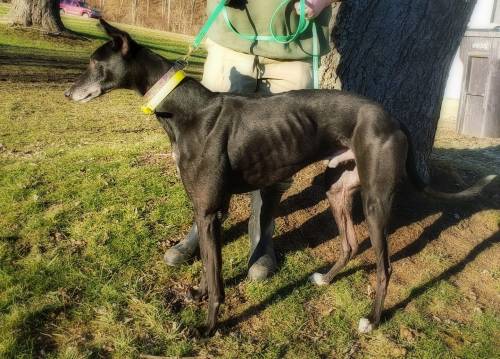
Posted in drake, tagged black greyhound, greyhound on December 25, 2019|
Posted in working dogs, tagged greyhound, racing greyhound on August 8, 2019| 9 Comments »
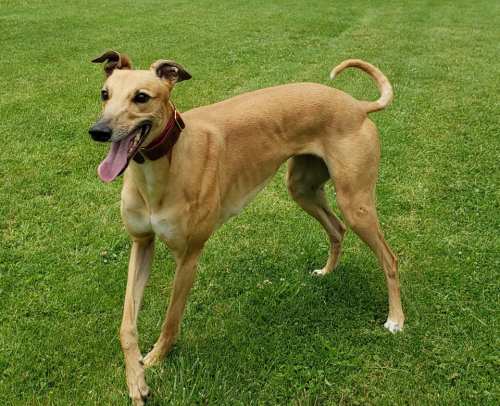
Update: I am pro-greyhound racing and pro-NGA. (I wrote a post opposing the Florida amendment last October.) The reason this litter will be AKC registered is that they are not being bred for professional racing. They are being bred for sport and coursing homes. My partner has years of experience working at racing greyhound kennels, and we are very sighthound savvy. We will not let someone walk away with a driven puppy without fully explaining the issues in raising and civilizing such a creature. The parents are going to be health tested (the Embark samples are in the mail). I don’t want racing greyhounds to wind up like otterhounds, where there are scarcely any left now that their main reason for existence has been banned.
Greyhound racing in the United States is on its way out. Florida was the last large state that had lots of tracks going, but in the 2018 general election, Florida voters decided to phase out professional greyhound racing.
In the short run, these dogs are going to filter their way into adoption. The vast majority of them will find homes. And every single one of them will be neutered.
Because only a handful of states will have racing, it is very unlikely that thousands of racing greyhounds will be bred every year. When this generation of adopted out greyhounds dies, the greyhound owning public will not have many options.
Yes, they can buy a show-bred greyhound, go out West and get a coursing dog, or they get a whippet or borzoi. I suspect that galgos from Spain will be imported over here in very high numbers.
But if they want a sport-bred greyhound that derives from racing lines, they will essentially be out of luck. However, they won’t be.
Several of us are close enough to forward-thinking racing dog owners to get our hands on intact racing greyhounds that we will be breeding. Erika is scheduled to be bred on her next heat, and we already have the sire picked out. Stay tuned for updates on him.
And we will do what we can to keep the American racing greyhound lines alive the best we can. We already have lots of homes lined up for this coming litter, so the demand for these dogs is quite high. The litter will be AKC-registered, so they can enter the “legit” greyhound population and do AKC-sanctioned events.
We will be helping these lines see a future beyond greyhound racing, and I have to say that I’m proud be part of this project.
So yeah, I’m deep in show dogs now, but we are working on keeping some nice working lines of a breed going into the future.
I’m pretty excited about it.
Posted in dog breeds, tagged greyhound, Greyhound Nation on March 25, 2019|

Many techniques of the study of history exist. One of the most innovative is what is called “environmental history” in which human castes, classes, and professions are given ecological/economic niches that allow their behavior to operate as if species in an ecosystem.
It is this history that Edmund Russell lays out in his Greyhound Nation: A Coevolutionary History of England, 1200-1900. This is a book that anyone interested in dog history should read, for it is an odd comprehensive history of the redefinition of a particular type of dog through the social, economic, and political changes of a nation shifting from feudalism to capitalism and democracy.
Russell’s book is not the history of “the greyhound,’ the breed we know today. That breed is included in this work, but it is also the history of the proto-whippets that worked the rabbit warrens and larger forms of greyhound that were used to hunt deer and wolves. It is also the story of eventual breed standardization within the context of the rise of the kennel club and the closed racing greyhound registries.
Russll begins with the earliest mentions of greyhounds in England, which is around the year 1200. The dogs belonged solely to the patrician class in the feudal system, and different forms of greyhound were used to on different quarry. Large greyhounds coursed the deer and the wolf. Mid-sized ones worked hares and foxes. Smaller ones were used to catch rabbits in enclosed warrens. And commoners were never allowed to own a any of these dogs, except under very explicit circumstances.
For over five centuries, various forms of greyhound were used in this way, but then in the late eighteenth century, the forces of democracy and early capitalism began to change the way the English related to their land. The Enclosure of the commons meant that vast tracts of territory could be set aside of the protection and promotion of hares for what was called “club coursing.”
In this coursing clubs, patricians ran their dogs on these hare estates. They were clubs that were quite exclusive, and the commoners could not own these dogs. Russell includes the account of a commoner convicted for owning greyhound, which the commoner tries to pass off as an Italian greyhound. But he is still convicted of the crime.
At this time, greyhounds are bred to lurchers and bulldogs to improve their runs on hares, and we learn about the various eccentricities of Lord Orford, a founder of the Swaffham Coursing Society. He was an extreme spendthrift, infamously selling countless priceless family paintings to Catherine the Great of Russia to pay off debts that he had accrued. He also died while running one of his hounds, Czarina, at a Swaffham meet. He had been ill but left his bed to run the hound. He is said to have either died in the saddle or fell from the saddle then died.
As the eighteenth century progresses into the nineteenth, big coursing events, called public coursing, became a popular rural activity. The famous Waterloo Cup began in 1836, and as the sport became popular for spectators, a National Coursing Club was founded to standardize coursing rules. Commoners were eventually allowed to own these dogs, and coursing became more democratic and meritocratic endeavor. The working classes begin to have leisure time and money, which they put toward gambling on coursing events and speculation on various hounds.
This democratic shift in coursing coincided with the rise of the Kennel Club and the purebred dog fancy. Here, Russell introduces us to Sewallis Shirley, the same founder of the Kennel Club and retriever fancier who has been mentioned on this blog many times. Russell portrays Shirley as purely patrician. He is anti-democratic and opposed to tenant rights on his estate in Ireland, and his anti-democratic leanings lead to his promotion of the show greyhound over the coursing one.
As the nineteenth century draws to a close, we see the closing of the greyhound registry with both the Kennel Club and the National Coursing Society. No longer would anyone consider crossing to lurchers or bulldogs to make a better greyhound. The goal was to produce a superior greyhound within the population already ascribed as greyhounds.
Russell leaves us at this juncture but alludes to the rise of greyhound racing in the twentieth century in which the dogs are reborn as objects on which to wager in a new event.
This type of history could, in theory, be written about any type of dog in virtually any European country. However, this particular breed in this particular country is documented well back in the Medieval period, and because it was owned solely by the wealthy originally, the documentation can be followed fairly easily into the modern era.
If one is interested in an academic history of dogs, this book is a great read. Russell uses the primary sources in his work so clearly, and the prose is posited so logically that one can easily follow the winding history of running dogs in England.
These dogs were made to run, but we now live in a world where they are slowly losing their purpose. Nation after nation, state after state, coursing is losing its legality. Professional greyhound racing is likely on the way out in much of the world, but we will keep them alive. We will run them, even if it is just after plastic bags raced along on pulleys.
Posted in Poet (whippet), tagged german shepherd, greyhound, whuooet on March 25, 2019|
Our travels took us the Ocala National Forest, where there are plenty of Dolomite roads to let the dogs rip.
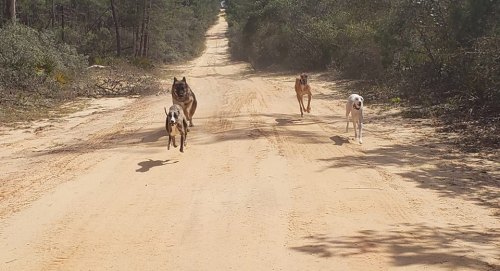
Posted in Erika, tagged greyhound, racing greyhound on February 21, 2019|
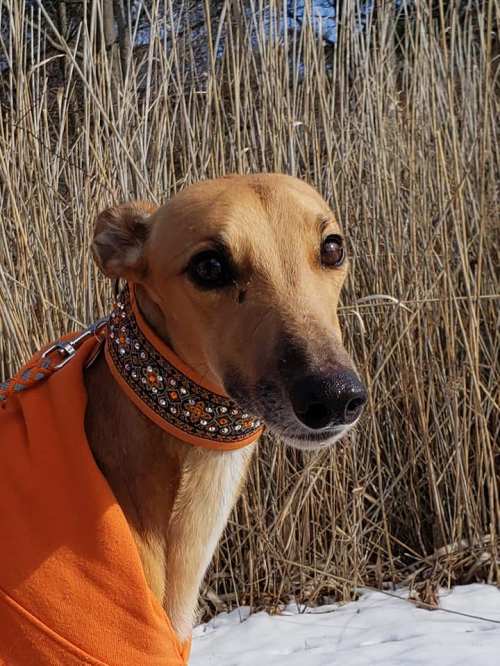
Erika is the top bitch in this house. Male puppies cannot bother her and certainly cannot hump her with impunity.
But she is a sweetheart who loves her people.
Posted in greyhound, Uncategorized, tagged greyhound, racing greyhound on February 1, 2019| 2 Comments »
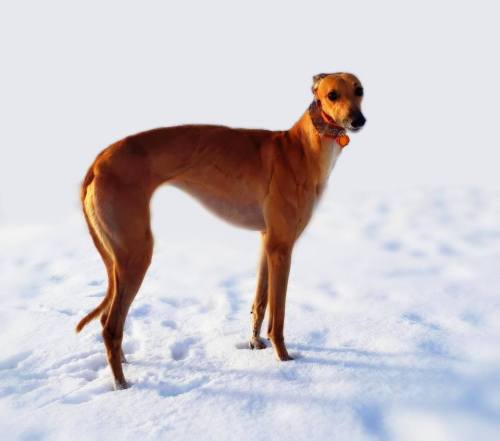
Erika the Red is our new racing greyhound bitch We do have a litter planned for later this year, and the puppies will be available for sporting homes.
We picked her up at Wheeling Island yesterday,, and with greyhound racing fading away, we’re going to try to keep these lines alive for the future.
She is a very gentle dog. Think giant whippet, and you’ll come close to describing her.
She gets along with all the whippets. Poet wants her BAD. And the Static thinks she is his mommy.
Posted in working dogs, tagged coursing, greyhound, Irish hare, mountain hare on January 19, 2019| 1 Comment »
I will be doing this soon enough, but with a whippet that will be sent after a plastic bag.
The hares being coursed and then cared for in this video are Irish hares, which are a unique subspecies of mountain or blue hare that is endemic to Ireland.
We do not have a hare for coursing in most of the Eastern US, so we’re bag chasers. There are some European brown hares that were introduced to New York State, and those would be the nearest coursing hares to me.
Snowshoe hares live deep in the coverts of mountain laurel and are usually taken with the use of beagles and basset hounds.
Posted in animal welfare, dog breeds, working dogs, tagged Amendment 13, greyhound, greyhound racing on October 29, 2018| 3 Comments »
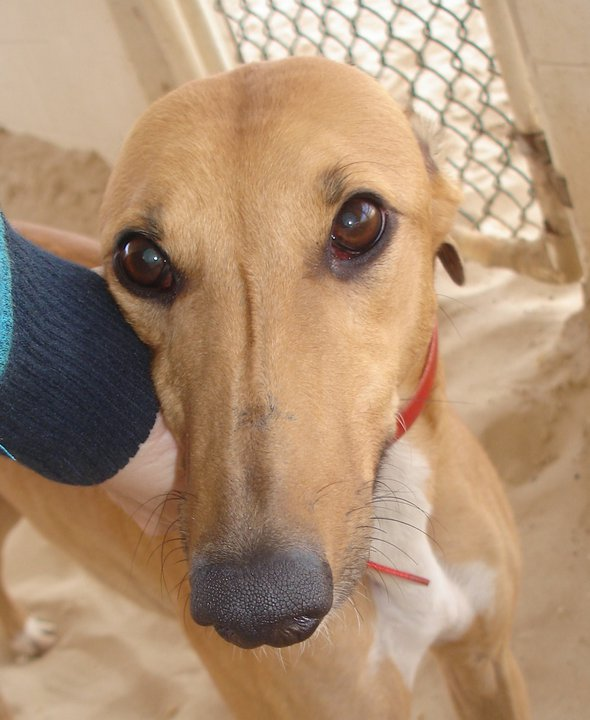
Beautiful N Red at turn out at Derby Lane. St. Petersburg, Florida, on Christmas Day 2010.
I am not known for my conservatism. Indeed, I am definitely on the other side of the spectrum, but on some issues, I am not an ideologue, especially those issues that deal with animals that have a purpose.
What I am about to write might cause me to lose some readership, but I feel I have to say what I do think about this issue. This issue is the continued existence of commercial racing greyhounds in North America.
Many states have banned wagering on greyhound. My native state of West Virginia is still one that is very much into greyhounds and wagering on them. The former governor’s family was a devotee of greyhounds and greyhound breeding, and his successor has made a point to keep the hounds subsidized in the state budget.
But West Virginia will not keep the practice alive. The real market for greyhound racing is in Florida, and now Amendment 13 is on the ballot for this coming election. My guess is that Florida will ban it. Democratic voter enthusiasm is way up in Florida, which is a good thing for 95 percent of the things I care about, but the odds that the typical Democratic voter is going to see through the nonsense that everyone “believes” about greyhound racing are not particularly high.
Greyhound racing may have been cruel in the past. They may have shot the racers after they couldn’t run anymore. They might have let the dogs run live meat rabbits that would be hung down from the lure.
I saw all these things on tabloid news shows when I was a kid, but I didn’t assume that the entire enterprise of greyhound was immoral. Even at that age, I thought they should just ban cruel practices, and I thought that greyhound adoption was just a great idea to stop people from shooting their retired dogs.
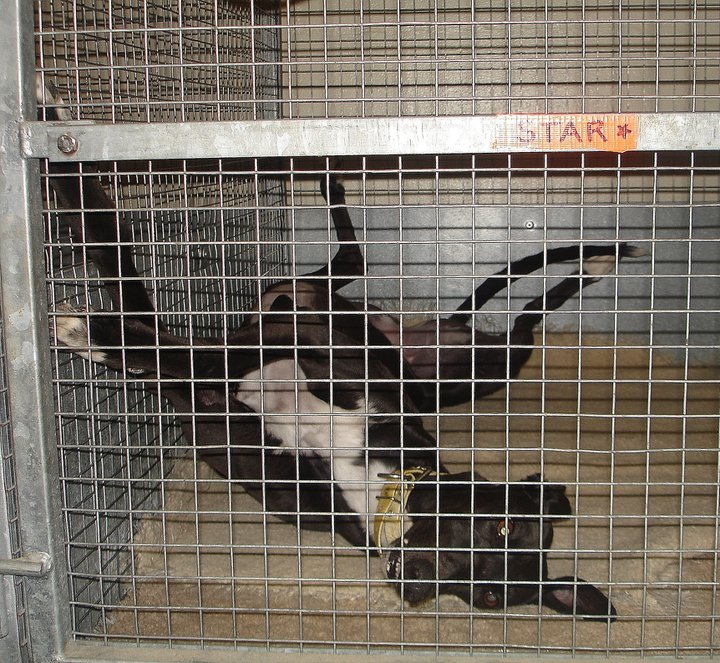
Star enjoying her spacious crate.
In the end, that’s what most states did for a while, but big money wanted the practice to end entirely. Casinos didn’t like having their revenue tied to racing, and many states had requirements that casino licenses be tied to greyhounds. Ban the practice, and the casino licenses would be liberated from the dogs and whatever fines and regulations go along with them.
I have come to know several track insiders, including my current partner. I’ve heard stories about the old trainers, true dogmen of the highest order. These were men who could tell which muscle was pulled simply by how the dog was limping and could tell you the bloodlines of the greyhound simply by looking at it.
They were not like the horse trainers who make massive salaries training their racers. These were men who made money on the dogs, but they lived mostly austere existences. The dogs were their passion, and the skillset was passed on from generation to generation. Whole families devoted themselves to breeding for and caring for the dogs.
If this Amendment 13 passes, the biggest state with legal greyhound racing will end this whole culture. All this knowledge and all this passion will be dashed away.
And all because people simply believe that greyhound racing is inherently cruel. I’ve been told by my friends in Florida that many dishonest political ads are filling the airways. Some are making claims of mass fatalities at tracks, with no supporting evidence given. One wag even put up a Halloween display showing greyhound tombstones with the names of greyhounds that supposedly died at the tracks. Strangely, people on social media who owned the dogs wound up sharing live photos of the dogs named on the fake monuments, showing that the dogs were not dead at all. They had been adopted.
Further, the end of greyhound racing is also the end of greyhound adoption. Many people have relied upon a steady supply of retired racers to fill their homes with their favorite breed.
What likely will happen is that those in the know will buy up racing greyhounds from the trainers and kennels. NGA dogs can still be registered in the AKC, and these dogs certainly will be. They will then be bred for amateur racing and dog sports, and because they will be bred like any other sport breed, you will likely be able get an eight-week-old puppy from a breeder. But you will pay a big price for it. The racing greyhound will become like the racing whippet, a dog owned by amateurs only, and not one easily procured at retirement.
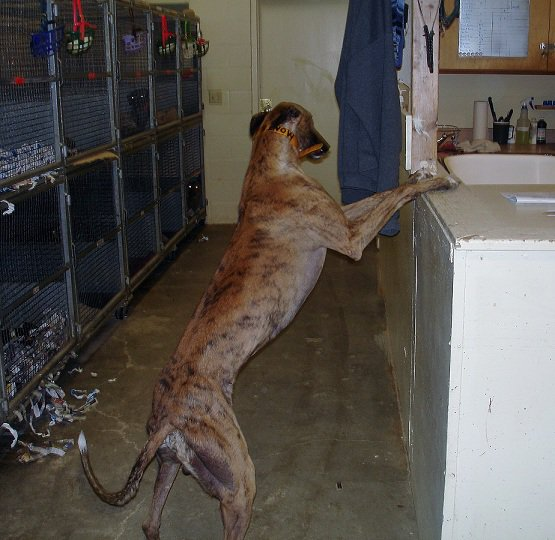
Fuzzface Monte counter-surfing at Derby Lane. Note the size of the crates in the background.
So people who own retired racers now are essentially setting up a situation where when their current dog dies, it will become so much harder to find another dog to fill the void.
I would urge Florida voters to vote down this Amendment 13. I would urge them to speak to the real greyhound people, who are not the monsters portrayed in 30 second ads. These are among the last of the true dogmen, and their ideas and thoughts and expertise are not to be laughed at.
And certainly not squelched because a well-funded animal rights campaign has deemed them and their livelihoods undesirable.
Posted in dog breeds, tagged corgi, greyhound, Lurcher, Pembroke Welsh corgi on November 15, 2012| 38 Comments »
Posted in working dogs, working retrievers, tagged greyhound, retriever, retrieving greyhound on June 24, 2011| 5 Comments »
This dog is described in a letter in Country Life Illustrated (19 December 1908):
Sir,
While out ferreting the other day at Parford, on Dartmoor, I took the photograph I enclose of a greyhound retrieving a rabbit, which I thought might be of interest to some of your readers. When this dog was out with us it was quite the exception for a wounded rabbit to get down a burrow; consequently, we were able to ferret the whole length of the hedges without leaving gaps, as is generally the case when one wants to avoid the chance of the ferrets laying up. The dog belongs to a keeper in Chagford, who told me he had great difficulty in training him in the first instance. If a rabbit was missed and bolted away from the hedge it was often caught and retrieved after an exciting course, which greatly added to the day’s sport and relieved monotony. As to the dog’s parents, I was unable to obtain any information, but he had the appearance of being a fairly well-bred dog (pg. 892).
That last line is used make certain that this dog is a greyhound and not a cross between a greyhound and a retriever.
The dog is mostly black, and that might suggest that someone bred a greyhound to a retriever at some point to get both the color and the behavior.
Grantley Berkeley did cross one of his deer greyhounds with a retrieving “Newfoundland.” The resulting puppy– Wolf– was a very sagacious retrieving lurcher.
There are certain greyhounds that will retrieve within the population, and these do not necessarily have retriever blood in them. The only characteristics that this particular dog has that might suggest retriever ancestry are its black color and the retrieving behavior.
But neither of these is necessarily indicative of being a greyhound/retriever cross of any sort.
The retrieving behavior is widely distributed among domestic dog breeds. My grandmother’s miniature dachshund, who ruled me with an iron fist (as would any Prussian autocrat worthy of the name) was an 8-pound retrieving fool.
And there are plenty of actual retrievers that would rather eat than retrieve anything.
Because retrieving is widespread in dogs, it makes sense that virtually all retrievers living in Britain had some level of crossbreeding. They were the performance-bred mongrels of the sporting gentry.